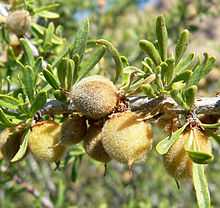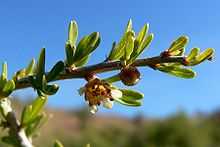Prunus fasciculata
| Prunus fasciculata | |
|---|---|
 | |
| Scientific classification | |
| Kingdom: | Plantae |
| (unranked): | Angiosperms |
| (unranked): | Eudicots |
| (unranked): | Rosids |
| Order: | Rosales |
| Family: | Rosaceae |
| Genus: | Prunus |
| Subgenus: | Emplectocladus |
| Species: | P. fasciculata |
| Binomial name | |
| Prunus fasciculata A. Gray | |
| Synonyms[1] | |
|
Emplectocladus fasciculata (Torr.) | |
Prunus fasciculata, also known as wild almond, desert almond, or desert peach[2] is a spiny and woody shrub producing wild almonds, native to the deserts of Arizona, California, Nevada and Utah.[1]
Prunus fasciculata lives many years (is perennial), and drops its leaves (deciduous).[1][3][4] It prefers sandy or rocky soil on dry slopes and washes up to an altitude of about 2200 m. (7500 feet).
Description
Prunus fasciculata grows up to 2 meters (6 feet) high, exceptionally larger, with horizontally branching (divaricate) branches, that may have a small amount of thorns (spinescent) often in thickets. The bark is grey and without hairs (glabrous).

The leaves are 5–10 mm long, narrow (linear), with a broad, flatten tip that tapers down to a more narrow base, (spatulate, oblanceolate), arranged on very short leaf stem (petiole) like bundles of needles (fascicles). The flowers are small and white with 3-mm petals, occurring either solitary or in fascicles and are without a petal stem (subsessile) growing from the leaf axils. They are dioecious. Male flowers have 10-15 stamens; female, one or more pistils. The plant displays numerous fragrant flowers from March to May, which attract the bees that pollinate it. The drupe is about 1 cm long, ovoid, light brown and pubescent with thin flesh.[5][6]
Uses
The plant is not cultivated. Some Native Americans in its limited range learned traditional ways of using it: the Cahuilla prepared the drupe as a delicacy. The wild almonds were considered a delicacy by Native Americans. The Kawaiisu found the tough twigs useful as drills in starting fires and as the front portion of arrow shafts.[7] The seed contains too much cyanide to be edible, but see under Paleobotanical evidence below.
Classification
The plant was first classified as Emplectocladus fasciculata in an 1853 paper by John Torrey based on a collection of the plants of California acquired during the third expedition of John C. Fremont in 1845;[8] whence the synonym Emplectocladus fasciculata (Torr.)[9] The work was illustrated by Isaac Sprague. Torrey devised the genus Empectocladus to comprise a few desert shrubs. According to Silas C. Mason[10] the genus has
- "... a top so densely branched, angled and interlocked as to well merit the name Emplectocladus (Greek, "woven branch"), signifying interlocked branches ...."
According to George Bentham and Joseph Dalton Hooker[11] the name fasciculata means that the leaves are in fascicles, or little bundles:
- "Leaves small, spatulate, as it were of precious stones, subglobose fasciculate"[12]
However, Asa Gray publishing in 1874 reclassified Empectocladus to Prunus resulting in the designation Prunus fasciculata (Torr.) A. Gray (subg. Emplectocladus), in which the desert shrubs become a subgenus.[13] Jepson[4] defines a California variety with smooth leaves, punctata, in comparison to which Gray's species, with pubescent leaves, becomes the variety, fasciculata. Punctata grows in the coastal ranges as well as in the desert.[14][15]
Palaeobotanical evidence
Middens from rodent activities such as those of the Pack rat are a rich source of plant macrofossils from late Pleistocene habitats. At Point of Rocks in Nevada by 11700 BP desert shrubs such as Desert Almond had replaced Juniper and Joshua trees, indicating the onset of the modern desert.[16] Somewhat earlier, 17000-14000 BP, Desert Almond flourished in a mixed desert and woodland ecology on the Colorado Plateau.[17]
There is some archaeological evidence that the seeds were pounded into flour and leached to make it edible by the ancient population of the Mojave desert.[18]
References
| Wikimedia Commons has media related to Prunus fasciculata. |
| Wikispecies has information related to: Prunus fasciculata |
- ↑ 1.0 1.1 1.2 U. S. Department of Agriculture (USDA). "Prunus fasciculata (Torr.) A. Gray". Germplasm Resources Information Network (GRIN) Taxonomy for Plants.
- ↑ Bailey, L.H., Bailey, E.Z., and the staff of the Liberty Hyde Bailey Hortorium. 1976. Hortus third: A concise dictionary of plants cultivated in the United States and Canada. Macmillan, New York.
- ↑ U. S. Department of Agriculture (USDA). "Emplectocladus fasciculata Torr.". Germplasm Resources Information Network (GRIN) Taxonomy for Plants.
- ↑ 4.0 4.1 Jepson, Willis Linn (1936). A Flora of California, Volume 2. Berkeley: University of California. pp. pages 229–230.
- ↑ Geological Survey of California (1880). Botany of California: Volume I: 2nd (Revised) Edition. Little, Brown, and Company. pp. page 168.
- ↑ Rydberg, Per Axel (1917). Flora of the Rocky Mountains and Adjacent Plains: Colorado, Utah, Wyoming, Idaho, Montana, Saskatchewan, Alberta and Neighboring Parts of Nebraska, South Dakota, North Dakota and British Columbia. New York: Published by the Author. pp. page 452.
- ↑ Moerman, Daniel E. (1998). Native American Ethnobotany. Portland, Cambride: Timber Press. pp. page 442. ISBN 0-88192-453-9.
- ↑ This famous expedition combined scientific and military operations, merging into the war with Mexico of 1848 and the acquisition of California for the United States. Fremont's mandate had been to explore Oregon. He followed secret orders to establish a presence in California. Apparently he did accomplish both scientific and military objectives (but not in Oregon) and the pre-publication in Torrey's paper of his remaining plant specimens (some had been lost on the Missouri) helped him during his later prosecutions for insubordination.
- ↑ Torrey, John (1854). "Plantae Fremontianae; or Descriptions of Plants Collected by Col. J. C. Fremont, in California". Smithsonian Contributions to Knowledge Volume 6 Paper 1. Washington, DC: Smithsonian Institution. The contents of this volume are stated in The American Catalogue of Books (1856). London: Sampson Low, Son & Co. pp. page 59. The paper, however, had already been published independently in April, 1853, according to Karslake, Frank (1971). Book-Auction Records. London, New York and Edinburgh: Dawsons of Pall Mall. pp. page 1050.
- ↑ Mason, Silas C. (1911). "U. S. Department of Agriculture Bureau of Plant Industry-Bulletin Nos. 192 to 197 Inclusive 1910-1911: Drought Resistance of the Olive in the Southwestern States". Bulletins of the Bureau of Plant Industry Nos. 192 to 197 Inclusive 1910-1911 XXV. Washington: Government Printing Office. pp. page 24.
- ↑ Bentham, George; Hooker, Joseph Dalton (1865). Genera plantarum ad exemplaria imprimis in herbariis kewensibus servata definita Volume I Part II. London: Lovell Reeve & Co. pp. page 614.
- ↑ "Folia minuta, spathulata, e gemmis subglobosis quasi fasciculata ...."
- ↑ "Proceedings of the American Academy of Arts and Sciences (1874)". 10:70.
- ↑ "ITIS Report".
- ↑ Stuart, John David; Sawyer, John O. (2001). Trees and Shrubs of California. University of California Press. pp. page 305. ISBN 0-520-22109-5.
- ↑ Sauer, Jonathan Deininger (1988). Plant Migration: the dynamics of geographic patterning in seed plant species. University of California Press. pp. page168. ISBN 0-520-06871-8.
- ↑ Anderson, R. Scott; Betancourt, Julio L.; Mead, Jim I.; Hevly, Richard H.; Adam, David P. (2000). "Middle- and late-Wisconsin paleobotanic and paleoclimatic records from the southern Colorado Plateau, USA". Palaeo 155: page 45. doi:10.1016/s0031-0182(99)00093-0. The article is available as a .pdf file at .
- ↑ Bond, Elaine Miller (Summer 2000). "Reading between the rocks: Exploring the connection between land and humans in the Granite Mountains". Transect 18 (1): page 23.
External links
- UC Jepson Manual treatment for Prunus fasciculata
- USDA Profile for Prunus fasciculata (desert almond)
- Prunus fasciculata - U.C. CalPhoto Gallery